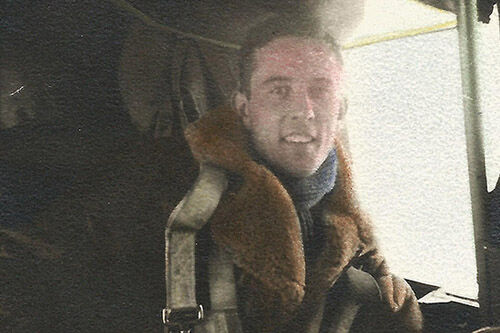
"Abandon aircraft chaps"
Published:
Categories:
Navigator John 'Jack' Lott had just celebrated his 25th birthday weeks before the D-Day landings, sadly this was the last birthday he would ever celebrate.
John 'Jack' Lott was born in Chiswick in 1919. First trained as a navigator in Canada, he returned to Britain and in early January 1944 was assigned to No. 619 Squadron as a navigator on Lancasters. It was in No. 619 Squadron that Jack met Flight Engineer Sergeant Jack Forrest, who fondly recalled him having a 'sardonic sense of humour and a prodigious memory'.
And it was in No. 619 Squadron that Jack took part in Bomber Command's attacks on occupied territory and, in particular, the Battle of Berlin. These attacks were dangerous and the odds of not returning high. On 1 July 1944, Commander-in-Chief of Bomber Command Air Chief Marshal Sir Arthur Harris wrote to the Chief of Air Staff saying, 'there are 10,500 air crew in my operational squadrons. In three months we have lost over half that number'.
It was against these odds that Jack and the rest of his air crew flew sorties to the occupied cities of Châteauroux, Tours, Toulouse, Salbris, Gennevilliers, Bourg-Leopold, and Amiens in France and Belgium, and beyond to the German cities of Magdeburg, Augsburg, Stuttgart, Frankfurt, Essen, Nuremburg, Brunswick, Munich, and Schweinfurt.
And while danger was ever present from flak and enemy fighters, further dangers awaited at home where wartime conditions, night landings, poor weather, and low visibility made landings difficult.
It was on landing after a return from a raid on Berlin that Jack's Lancaster crashed. While the aircraft was written off and the rear gunner had severe injuries, the rest of the crew escaped with minor wounds. Jack Forrest, the flight engineer, recalled, 'I woke up in the wreckage of the Lancaster with the trunk of a tree an inch or two away from my face…Berlin had been more welcoming'.
But it was in support of the D-Day invasion that Jack's luck ran out. Just after midnight on 7 June, Jack and his crew took off to attack a road and rail bridge at Caen.
Setting their course for home afterwards and flying low at less than 2,000 feet, the plane was shot by an enemy fighter. As Australian pilot Kim Roberts was taking evasive action, 'the fighter came in again, guns and cannons blazing, and the inner port engine caught fire,' recalled Jack Forrest. With three Merlin engines on fire, Roberts gave the order to 'Abandon aircraft chaps'.
Five members of Jack's crew died that day. Jack, Mid Upper Gunner 'Johnny' Williams, and rear gunner Guy Wyand are buried at Bayeux War Cemetery and Wireless Operator John Tucker is buried at Tilly-sur-Seulles War Cemetery.
The body of pilot Kim Roberts was never recovered; his name is inscribed on the Air Forces Memorial at Runnymede which commemorates those with no known grave. Only Air Bomber Reg de Viell and Flight Engineer Jack Forrest survived. Within days they were captured and held as prisoners of war.
This blog is dedicated to Jack Lott, the crew of his Lancaster, and to the 55,573 young Bomber Command airmen who lost their lives.
Thanks to D-Day Bomber Command: Failed to Return by Fighting High Publishing, www.fightinghigh.com.